Alba Edible Oil: A Comparative Analysis of Japan and Thailand Markets
VerifiedAdded on 2023/06/04
|16
|2314
|336
Report
AI Summary
This report evaluates the market potential of Japan and Thailand for Alba Edible Oils, an Australian company. It includes a company profile of Alba, highlighting their operations and goals. A PEST analysis is conducted for both countries, revealing that Thailand presents a more favorable market due to its growth stage in the product lifecycle and lower competition. The report also analyzes competitors and target buyers, suggesting a focus on health-conscious consumers. Joint venture strategy is identified as the most effective entry mode for Alba in Thailand, allowing partnership with a local firm to reduce risk and leverage local market knowledge. The conclusion emphasizes Thailand's potential for Alba compared to the saturated market of Japan, recommending a joint venture approach to establish a strong market presence.
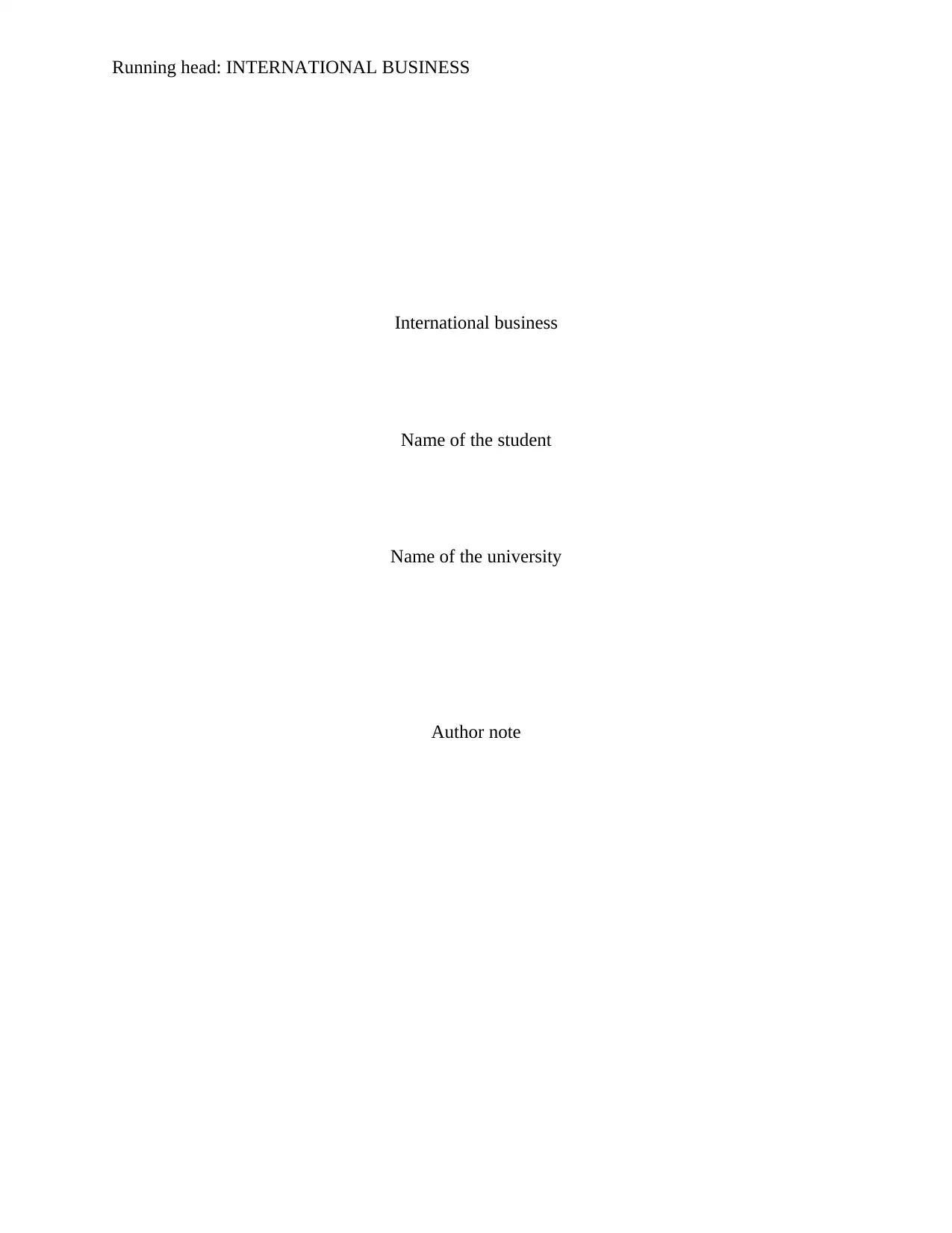
Running head: INTERNATIONAL BUSINESS
International business
Name of the student
Name of the university
Author note
International business
Name of the student
Name of the university
Author note
Paraphrase This Document
Need a fresh take? Get an instant paraphrase of this document with our AI Paraphraser
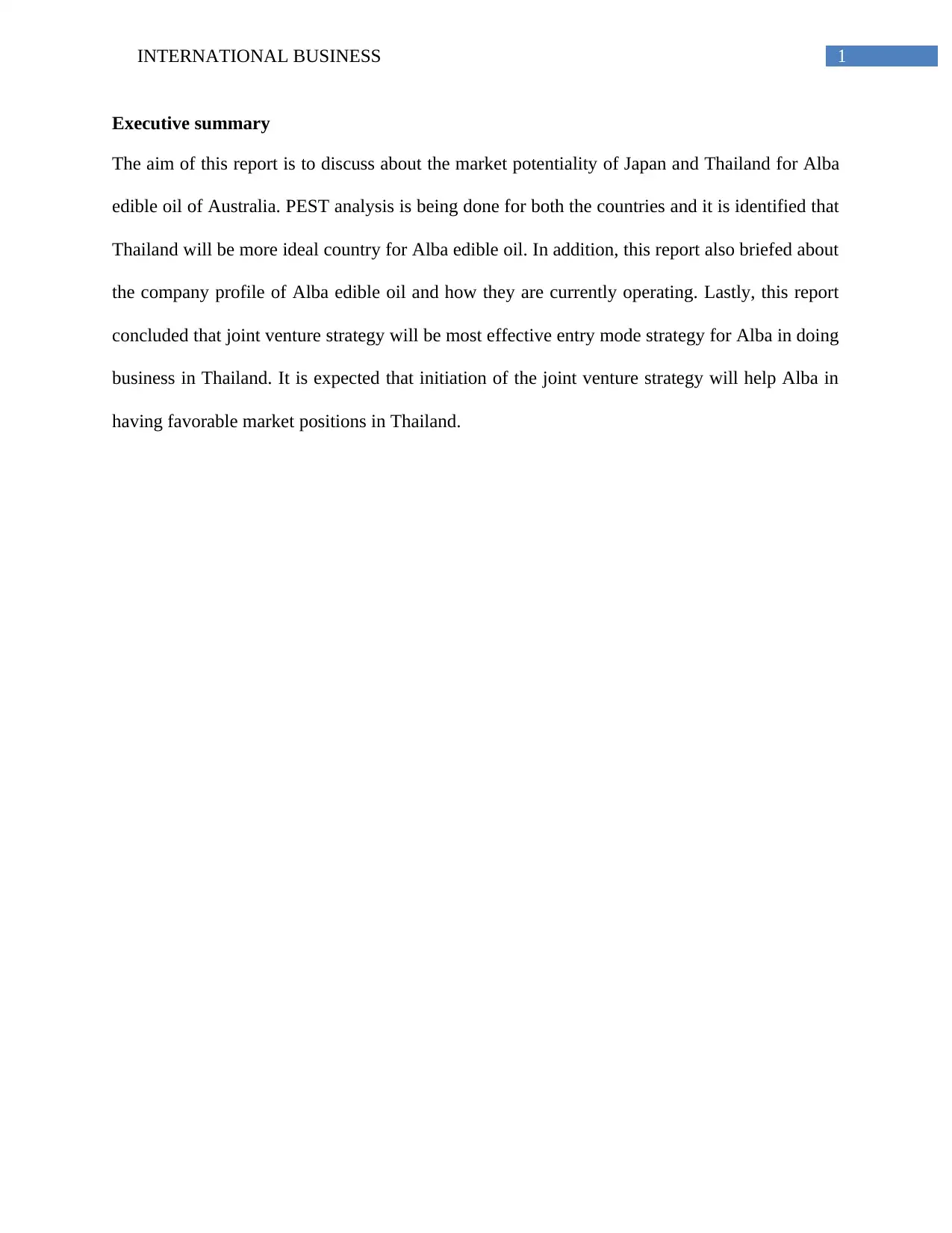
1INTERNATIONAL BUSINESS
Executive summary
The aim of this report is to discuss about the market potentiality of Japan and Thailand for Alba
edible oil of Australia. PEST analysis is being done for both the countries and it is identified that
Thailand will be more ideal country for Alba edible oil. In addition, this report also briefed about
the company profile of Alba edible oil and how they are currently operating. Lastly, this report
concluded that joint venture strategy will be most effective entry mode strategy for Alba in doing
business in Thailand. It is expected that initiation of the joint venture strategy will help Alba in
having favorable market positions in Thailand.
Executive summary
The aim of this report is to discuss about the market potentiality of Japan and Thailand for Alba
edible oil of Australia. PEST analysis is being done for both the countries and it is identified that
Thailand will be more ideal country for Alba edible oil. In addition, this report also briefed about
the company profile of Alba edible oil and how they are currently operating. Lastly, this report
concluded that joint venture strategy will be most effective entry mode strategy for Alba in doing
business in Thailand. It is expected that initiation of the joint venture strategy will help Alba in
having favorable market positions in Thailand.
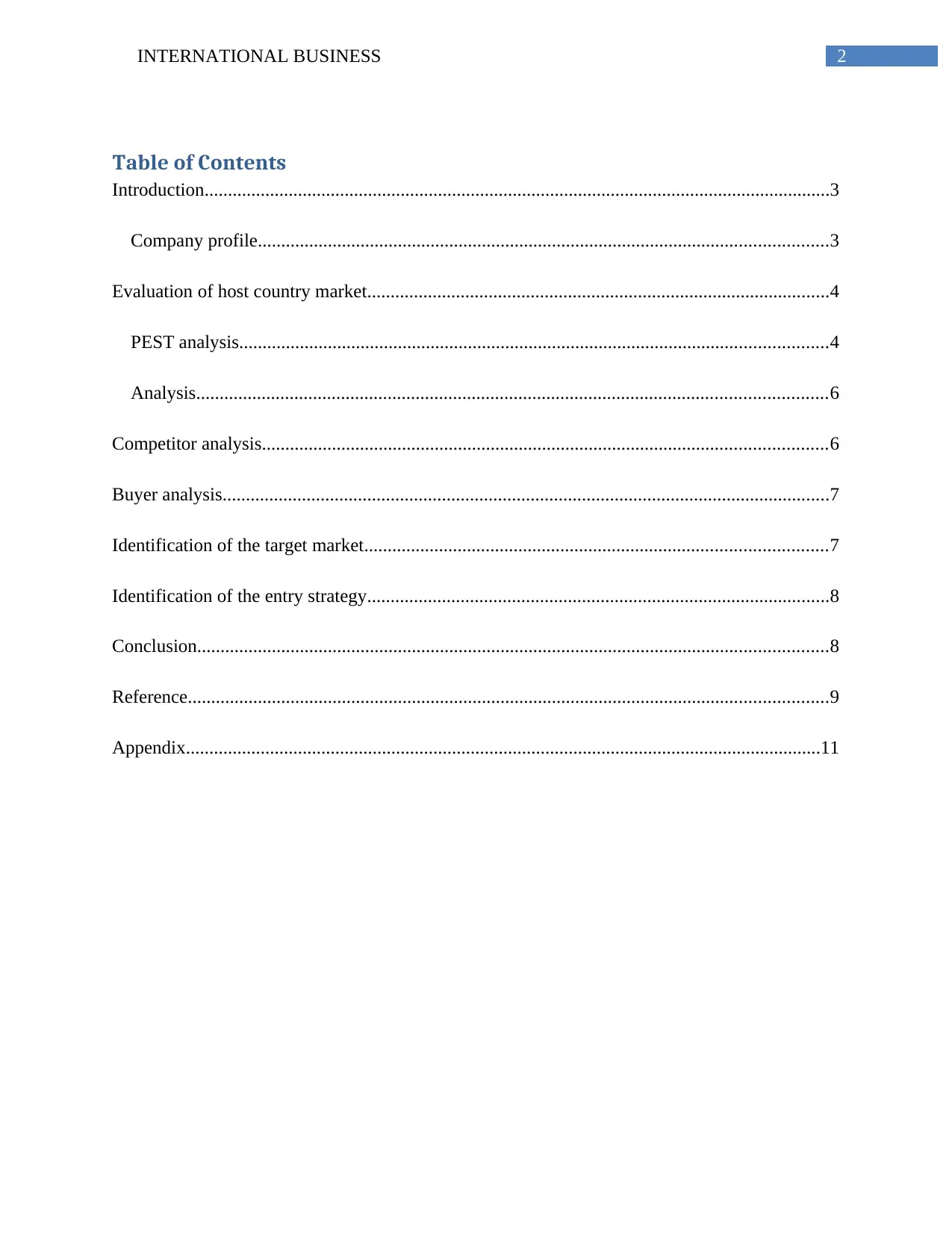
2INTERNATIONAL BUSINESS
Table of Contents
Introduction......................................................................................................................................3
Company profile..........................................................................................................................3
Evaluation of host country market...................................................................................................4
PEST analysis..............................................................................................................................4
Analysis.......................................................................................................................................6
Competitor analysis.........................................................................................................................6
Buyer analysis..................................................................................................................................7
Identification of the target market...................................................................................................7
Identification of the entry strategy...................................................................................................8
Conclusion.......................................................................................................................................8
Reference.........................................................................................................................................9
Appendix........................................................................................................................................11
Table of Contents
Introduction......................................................................................................................................3
Company profile..........................................................................................................................3
Evaluation of host country market...................................................................................................4
PEST analysis..............................................................................................................................4
Analysis.......................................................................................................................................6
Competitor analysis.........................................................................................................................6
Buyer analysis..................................................................................................................................7
Identification of the target market...................................................................................................7
Identification of the entry strategy...................................................................................................8
Conclusion.......................................................................................................................................8
Reference.........................................................................................................................................9
Appendix........................................................................................................................................11
⊘ This is a preview!⊘
Do you want full access?
Subscribe today to unlock all pages.

Trusted by 1+ million students worldwide
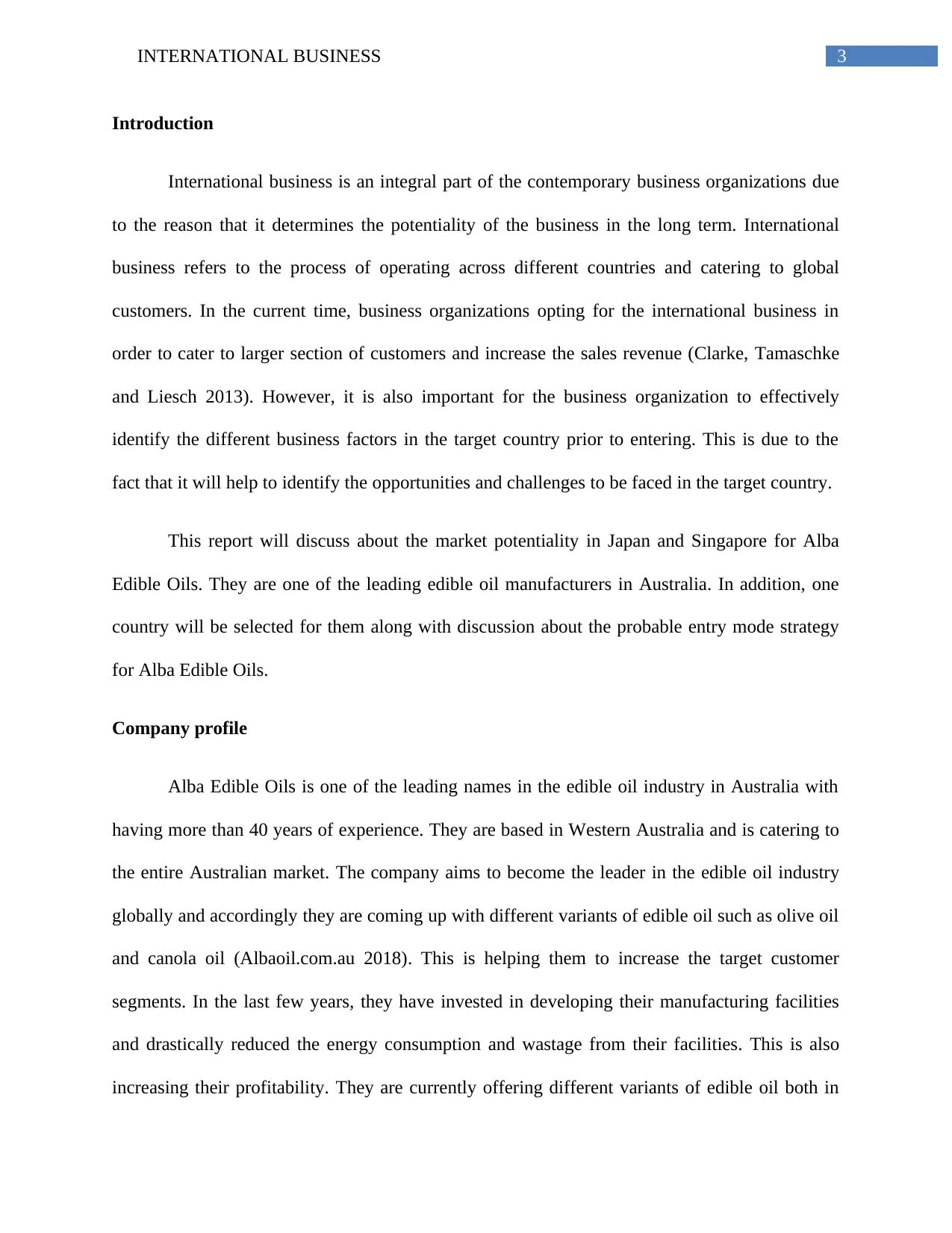
3INTERNATIONAL BUSINESS
Introduction
International business is an integral part of the contemporary business organizations due
to the reason that it determines the potentiality of the business in the long term. International
business refers to the process of operating across different countries and catering to global
customers. In the current time, business organizations opting for the international business in
order to cater to larger section of customers and increase the sales revenue (Clarke, Tamaschke
and Liesch 2013). However, it is also important for the business organization to effectively
identify the different business factors in the target country prior to entering. This is due to the
fact that it will help to identify the opportunities and challenges to be faced in the target country.
This report will discuss about the market potentiality in Japan and Singapore for Alba
Edible Oils. They are one of the leading edible oil manufacturers in Australia. In addition, one
country will be selected for them along with discussion about the probable entry mode strategy
for Alba Edible Oils.
Company profile
Alba Edible Oils is one of the leading names in the edible oil industry in Australia with
having more than 40 years of experience. They are based in Western Australia and is catering to
the entire Australian market. The company aims to become the leader in the edible oil industry
globally and accordingly they are coming up with different variants of edible oil such as olive oil
and canola oil (Albaoil.com.au 2018). This is helping them to increase the target customer
segments. In the last few years, they have invested in developing their manufacturing facilities
and drastically reduced the energy consumption and wastage from their facilities. This is also
increasing their profitability. They are currently offering different variants of edible oil both in
Introduction
International business is an integral part of the contemporary business organizations due
to the reason that it determines the potentiality of the business in the long term. International
business refers to the process of operating across different countries and catering to global
customers. In the current time, business organizations opting for the international business in
order to cater to larger section of customers and increase the sales revenue (Clarke, Tamaschke
and Liesch 2013). However, it is also important for the business organization to effectively
identify the different business factors in the target country prior to entering. This is due to the
fact that it will help to identify the opportunities and challenges to be faced in the target country.
This report will discuss about the market potentiality in Japan and Singapore for Alba
Edible Oils. They are one of the leading edible oil manufacturers in Australia. In addition, one
country will be selected for them along with discussion about the probable entry mode strategy
for Alba Edible Oils.
Company profile
Alba Edible Oils is one of the leading names in the edible oil industry in Australia with
having more than 40 years of experience. They are based in Western Australia and is catering to
the entire Australian market. The company aims to become the leader in the edible oil industry
globally and accordingly they are coming up with different variants of edible oil such as olive oil
and canola oil (Albaoil.com.au 2018). This is helping them to increase the target customer
segments. In the last few years, they have invested in developing their manufacturing facilities
and drastically reduced the energy consumption and wastage from their facilities. This is also
increasing their profitability. They are currently offering different variants of edible oil both in
Paraphrase This Document
Need a fresh take? Get an instant paraphrase of this document with our AI Paraphraser
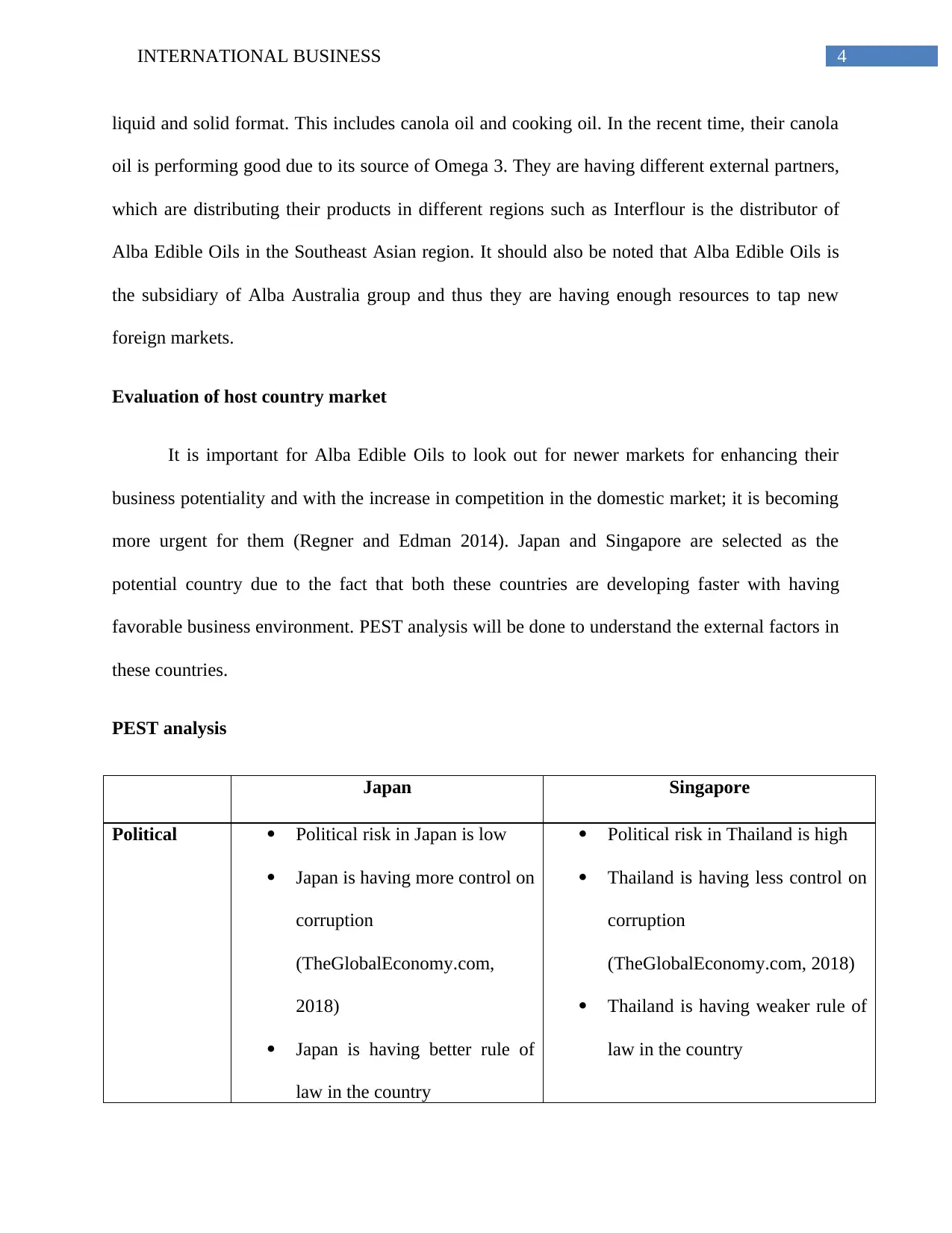
4INTERNATIONAL BUSINESS
liquid and solid format. This includes canola oil and cooking oil. In the recent time, their canola
oil is performing good due to its source of Omega 3. They are having different external partners,
which are distributing their products in different regions such as Interflour is the distributor of
Alba Edible Oils in the Southeast Asian region. It should also be noted that Alba Edible Oils is
the subsidiary of Alba Australia group and thus they are having enough resources to tap new
foreign markets.
Evaluation of host country market
It is important for Alba Edible Oils to look out for newer markets for enhancing their
business potentiality and with the increase in competition in the domestic market; it is becoming
more urgent for them (Regner and Edman 2014). Japan and Singapore are selected as the
potential country due to the fact that both these countries are developing faster with having
favorable business environment. PEST analysis will be done to understand the external factors in
these countries.
PEST analysis
Japan Singapore
Political Political risk in Japan is low
Japan is having more control on
corruption
(TheGlobalEconomy.com,
2018)
Japan is having better rule of
law in the country
Political risk in Thailand is high
Thailand is having less control on
corruption
(TheGlobalEconomy.com, 2018)
Thailand is having weaker rule of
law in the country
liquid and solid format. This includes canola oil and cooking oil. In the recent time, their canola
oil is performing good due to its source of Omega 3. They are having different external partners,
which are distributing their products in different regions such as Interflour is the distributor of
Alba Edible Oils in the Southeast Asian region. It should also be noted that Alba Edible Oils is
the subsidiary of Alba Australia group and thus they are having enough resources to tap new
foreign markets.
Evaluation of host country market
It is important for Alba Edible Oils to look out for newer markets for enhancing their
business potentiality and with the increase in competition in the domestic market; it is becoming
more urgent for them (Regner and Edman 2014). Japan and Singapore are selected as the
potential country due to the fact that both these countries are developing faster with having
favorable business environment. PEST analysis will be done to understand the external factors in
these countries.
PEST analysis
Japan Singapore
Political Political risk in Japan is low
Japan is having more control on
corruption
(TheGlobalEconomy.com,
2018)
Japan is having better rule of
law in the country
Political risk in Thailand is high
Thailand is having less control on
corruption
(TheGlobalEconomy.com, 2018)
Thailand is having weaker rule of
law in the country
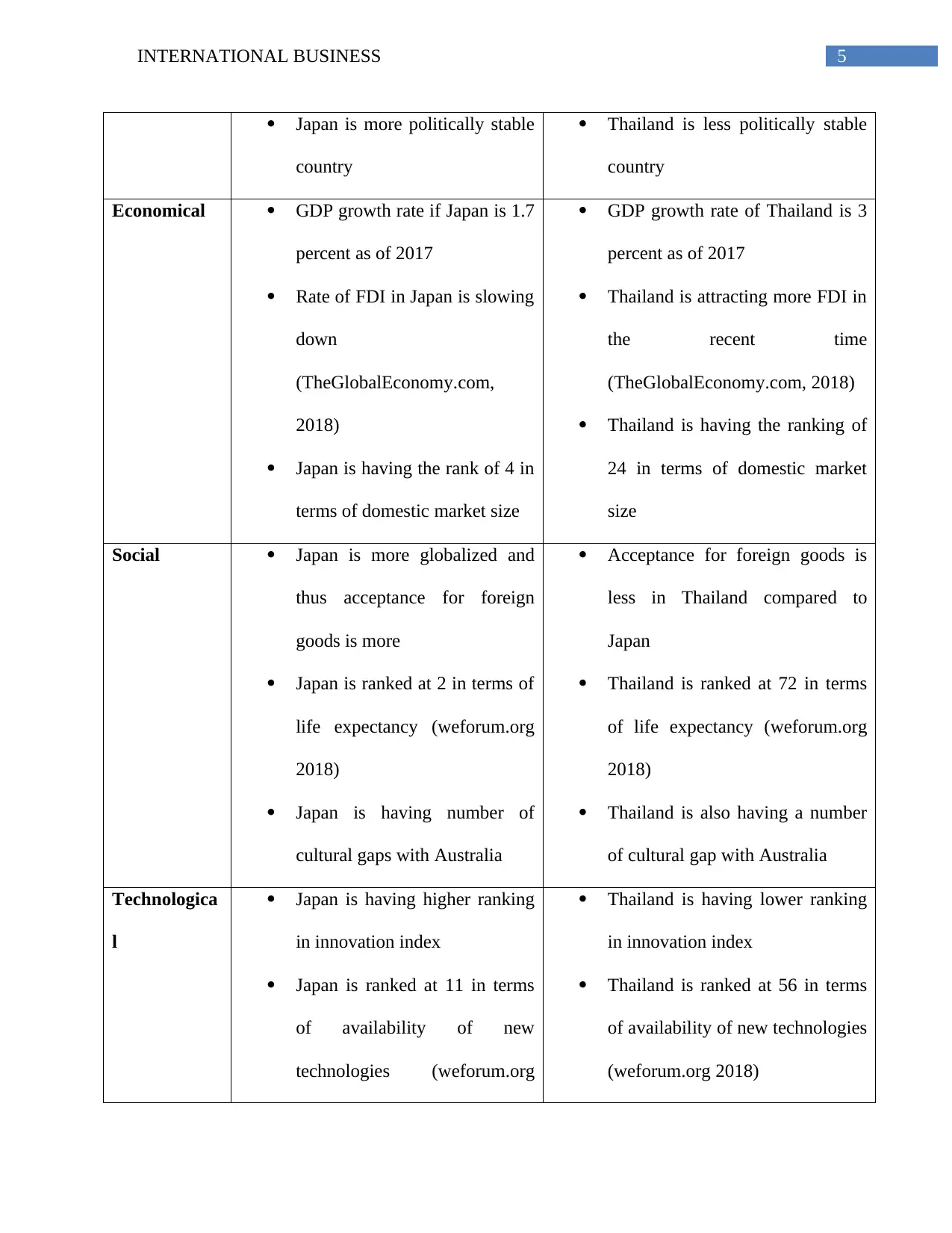
5INTERNATIONAL BUSINESS
Japan is more politically stable
country
Thailand is less politically stable
country
Economical GDP growth rate if Japan is 1.7
percent as of 2017
Rate of FDI in Japan is slowing
down
(TheGlobalEconomy.com,
2018)
Japan is having the rank of 4 in
terms of domestic market size
GDP growth rate of Thailand is 3
percent as of 2017
Thailand is attracting more FDI in
the recent time
(TheGlobalEconomy.com, 2018)
Thailand is having the ranking of
24 in terms of domestic market
size
Social Japan is more globalized and
thus acceptance for foreign
goods is more
Japan is ranked at 2 in terms of
life expectancy (weforum.org
2018)
Japan is having number of
cultural gaps with Australia
Acceptance for foreign goods is
less in Thailand compared to
Japan
Thailand is ranked at 72 in terms
of life expectancy (weforum.org
2018)
Thailand is also having a number
of cultural gap with Australia
Technologica
l
Japan is having higher ranking
in innovation index
Japan is ranked at 11 in terms
of availability of new
technologies (weforum.org
Thailand is having lower ranking
in innovation index
Thailand is ranked at 56 in terms
of availability of new technologies
(weforum.org 2018)
Japan is more politically stable
country
Thailand is less politically stable
country
Economical GDP growth rate if Japan is 1.7
percent as of 2017
Rate of FDI in Japan is slowing
down
(TheGlobalEconomy.com,
2018)
Japan is having the rank of 4 in
terms of domestic market size
GDP growth rate of Thailand is 3
percent as of 2017
Thailand is attracting more FDI in
the recent time
(TheGlobalEconomy.com, 2018)
Thailand is having the ranking of
24 in terms of domestic market
size
Social Japan is more globalized and
thus acceptance for foreign
goods is more
Japan is ranked at 2 in terms of
life expectancy (weforum.org
2018)
Japan is having number of
cultural gaps with Australia
Acceptance for foreign goods is
less in Thailand compared to
Japan
Thailand is ranked at 72 in terms
of life expectancy (weforum.org
2018)
Thailand is also having a number
of cultural gap with Australia
Technologica
l
Japan is having higher ranking
in innovation index
Japan is ranked at 11 in terms
of availability of new
technologies (weforum.org
Thailand is having lower ranking
in innovation index
Thailand is ranked at 56 in terms
of availability of new technologies
(weforum.org 2018)
⊘ This is a preview!⊘
Do you want full access?
Subscribe today to unlock all pages.

Trusted by 1+ million students worldwide
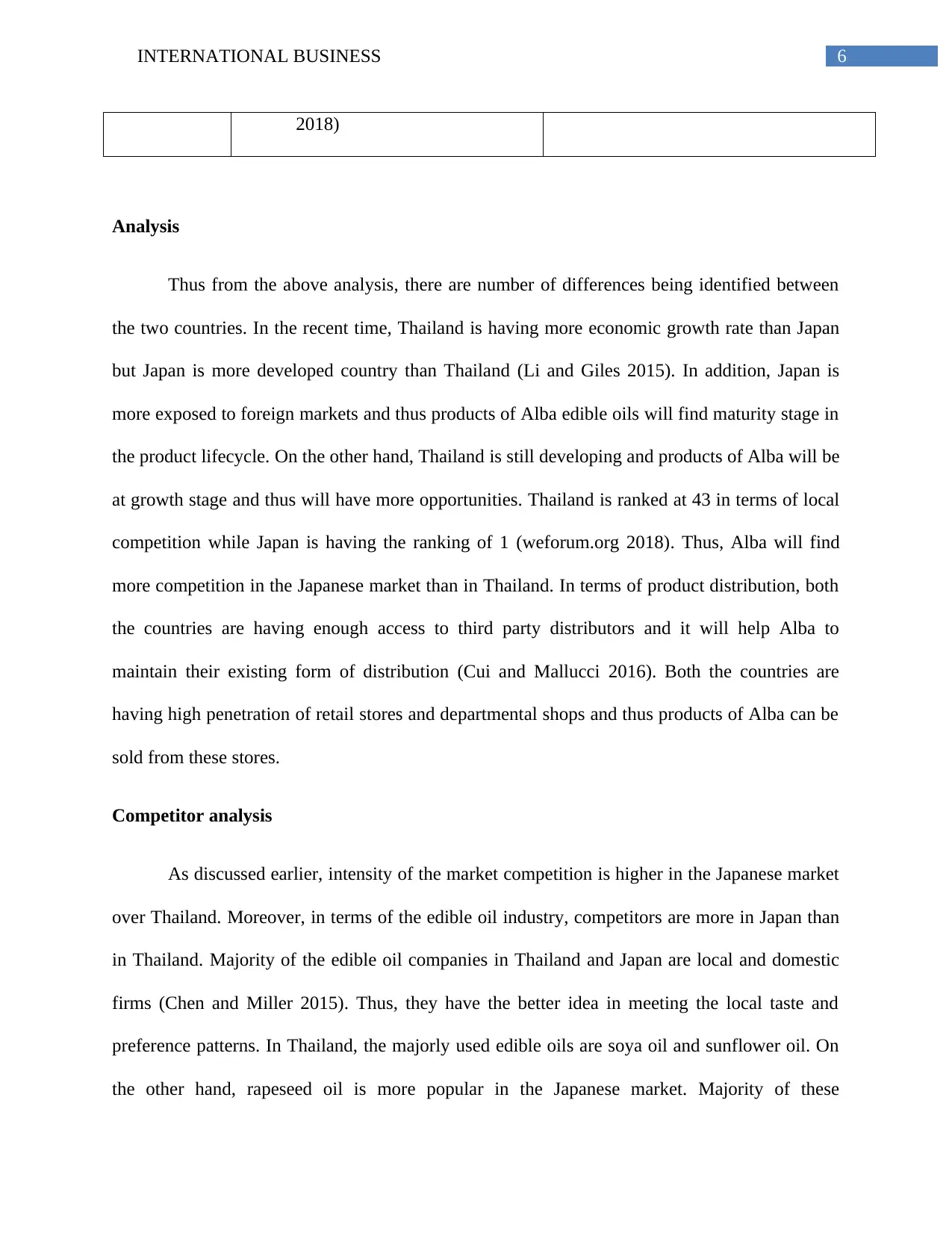
6INTERNATIONAL BUSINESS
2018)
Analysis
Thus from the above analysis, there are number of differences being identified between
the two countries. In the recent time, Thailand is having more economic growth rate than Japan
but Japan is more developed country than Thailand (Li and Giles 2015). In addition, Japan is
more exposed to foreign markets and thus products of Alba edible oils will find maturity stage in
the product lifecycle. On the other hand, Thailand is still developing and products of Alba will be
at growth stage and thus will have more opportunities. Thailand is ranked at 43 in terms of local
competition while Japan is having the ranking of 1 (weforum.org 2018). Thus, Alba will find
more competition in the Japanese market than in Thailand. In terms of product distribution, both
the countries are having enough access to third party distributors and it will help Alba to
maintain their existing form of distribution (Cui and Mallucci 2016). Both the countries are
having high penetration of retail stores and departmental shops and thus products of Alba can be
sold from these stores.
Competitor analysis
As discussed earlier, intensity of the market competition is higher in the Japanese market
over Thailand. Moreover, in terms of the edible oil industry, competitors are more in Japan than
in Thailand. Majority of the edible oil companies in Thailand and Japan are local and domestic
firms (Chen and Miller 2015). Thus, they have the better idea in meeting the local taste and
preference patterns. In Thailand, the majorly used edible oils are soya oil and sunflower oil. On
the other hand, rapeseed oil is more popular in the Japanese market. Majority of these
2018)
Analysis
Thus from the above analysis, there are number of differences being identified between
the two countries. In the recent time, Thailand is having more economic growth rate than Japan
but Japan is more developed country than Thailand (Li and Giles 2015). In addition, Japan is
more exposed to foreign markets and thus products of Alba edible oils will find maturity stage in
the product lifecycle. On the other hand, Thailand is still developing and products of Alba will be
at growth stage and thus will have more opportunities. Thailand is ranked at 43 in terms of local
competition while Japan is having the ranking of 1 (weforum.org 2018). Thus, Alba will find
more competition in the Japanese market than in Thailand. In terms of product distribution, both
the countries are having enough access to third party distributors and it will help Alba to
maintain their existing form of distribution (Cui and Mallucci 2016). Both the countries are
having high penetration of retail stores and departmental shops and thus products of Alba can be
sold from these stores.
Competitor analysis
As discussed earlier, intensity of the market competition is higher in the Japanese market
over Thailand. Moreover, in terms of the edible oil industry, competitors are more in Japan than
in Thailand. Majority of the edible oil companies in Thailand and Japan are local and domestic
firms (Chen and Miller 2015). Thus, they have the better idea in meeting the local taste and
preference patterns. In Thailand, the majorly used edible oils are soya oil and sunflower oil. On
the other hand, rapeseed oil is more popular in the Japanese market. Majority of these
Paraphrase This Document
Need a fresh take? Get an instant paraphrase of this document with our AI Paraphraser
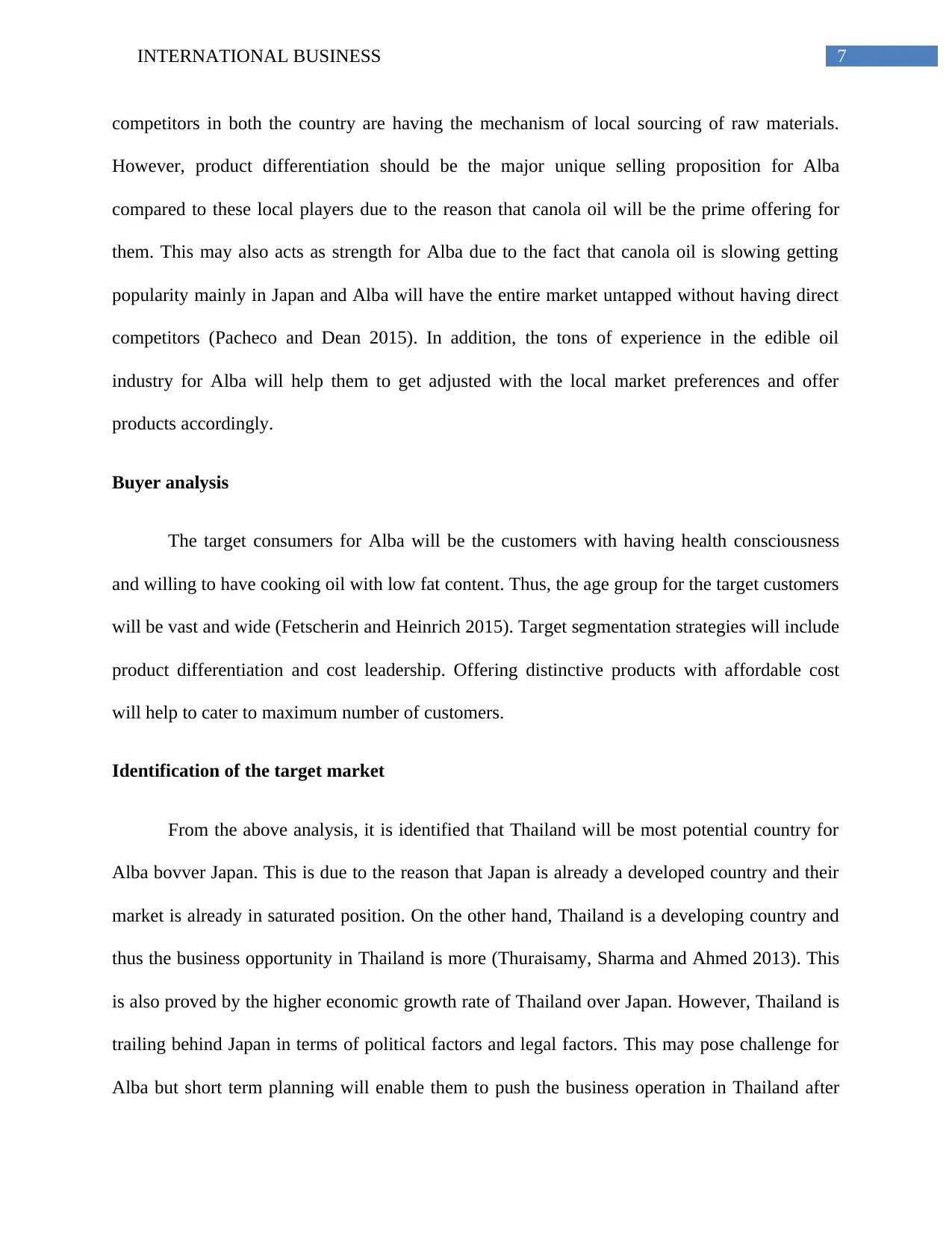
7INTERNATIONAL BUSINESS
competitors in both the country are having the mechanism of local sourcing of raw materials.
However, product differentiation should be the major unique selling proposition for Alba
compared to these local players due to the reason that canola oil will be the prime offering for
them. This may also acts as strength for Alba due to the fact that canola oil is slowing getting
popularity mainly in Japan and Alba will have the entire market untapped without having direct
competitors (Pacheco and Dean 2015). In addition, the tons of experience in the edible oil
industry for Alba will help them to get adjusted with the local market preferences and offer
products accordingly.
Buyer analysis
The target consumers for Alba will be the customers with having health consciousness
and willing to have cooking oil with low fat content. Thus, the age group for the target customers
will be vast and wide (Fetscherin and Heinrich 2015). Target segmentation strategies will include
product differentiation and cost leadership. Offering distinctive products with affordable cost
will help to cater to maximum number of customers.
Identification of the target market
From the above analysis, it is identified that Thailand will be most potential country for
Alba bovver Japan. This is due to the reason that Japan is already a developed country and their
market is already in saturated position. On the other hand, Thailand is a developing country and
thus the business opportunity in Thailand is more (Thuraisamy, Sharma and Ahmed 2013). This
is also proved by the higher economic growth rate of Thailand over Japan. However, Thailand is
trailing behind Japan in terms of political factors and legal factors. This may pose challenge for
Alba but short term planning will enable them to push the business operation in Thailand after
competitors in both the country are having the mechanism of local sourcing of raw materials.
However, product differentiation should be the major unique selling proposition for Alba
compared to these local players due to the reason that canola oil will be the prime offering for
them. This may also acts as strength for Alba due to the fact that canola oil is slowing getting
popularity mainly in Japan and Alba will have the entire market untapped without having direct
competitors (Pacheco and Dean 2015). In addition, the tons of experience in the edible oil
industry for Alba will help them to get adjusted with the local market preferences and offer
products accordingly.
Buyer analysis
The target consumers for Alba will be the customers with having health consciousness
and willing to have cooking oil with low fat content. Thus, the age group for the target customers
will be vast and wide (Fetscherin and Heinrich 2015). Target segmentation strategies will include
product differentiation and cost leadership. Offering distinctive products with affordable cost
will help to cater to maximum number of customers.
Identification of the target market
From the above analysis, it is identified that Thailand will be most potential country for
Alba bovver Japan. This is due to the reason that Japan is already a developed country and their
market is already in saturated position. On the other hand, Thailand is a developing country and
thus the business opportunity in Thailand is more (Thuraisamy, Sharma and Ahmed 2013). This
is also proved by the higher economic growth rate of Thailand over Japan. However, Thailand is
trailing behind Japan in terms of political factors and legal factors. This may pose challenge for
Alba but short term planning will enable them to push the business operation in Thailand after
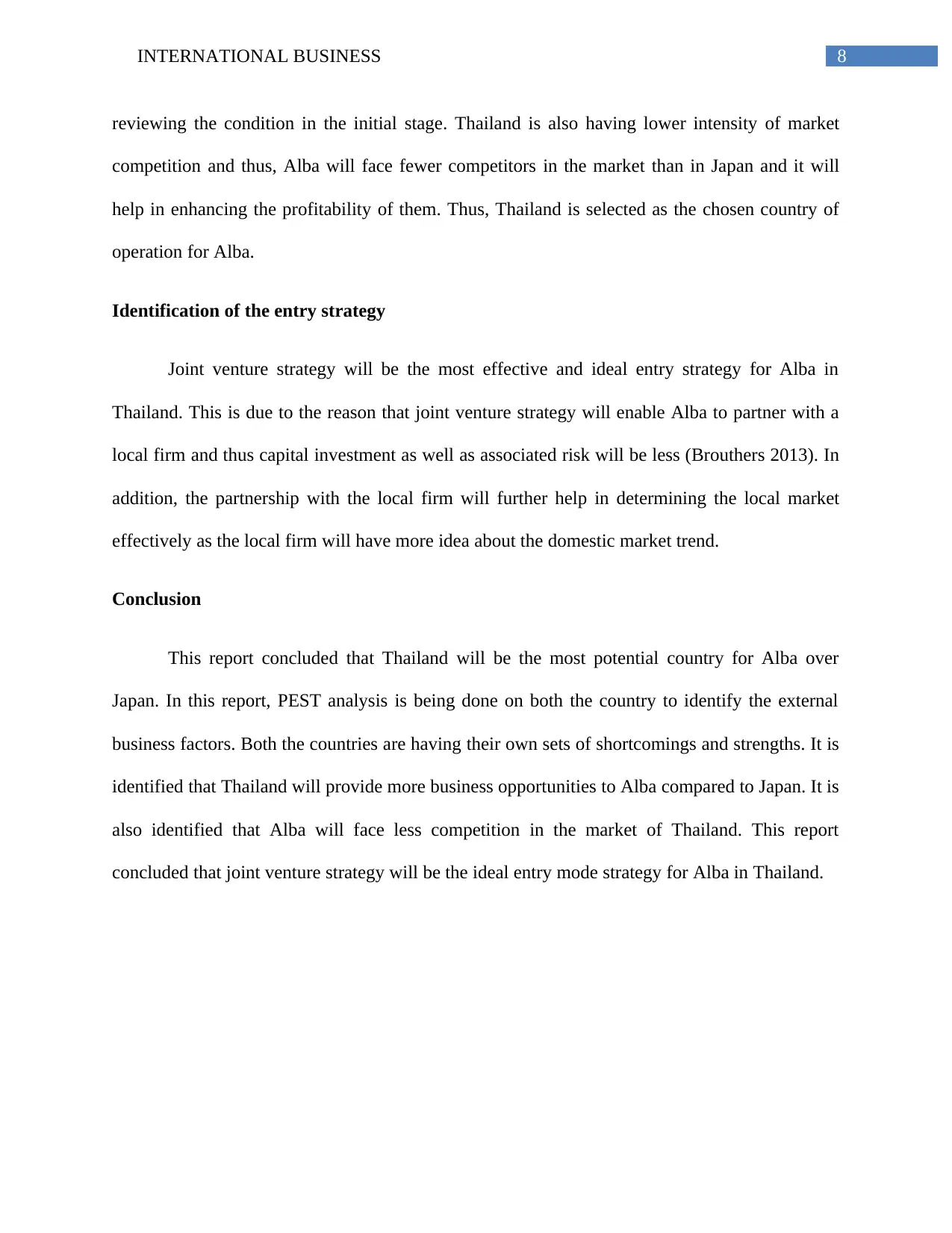
8INTERNATIONAL BUSINESS
reviewing the condition in the initial stage. Thailand is also having lower intensity of market
competition and thus, Alba will face fewer competitors in the market than in Japan and it will
help in enhancing the profitability of them. Thus, Thailand is selected as the chosen country of
operation for Alba.
Identification of the entry strategy
Joint venture strategy will be the most effective and ideal entry strategy for Alba in
Thailand. This is due to the reason that joint venture strategy will enable Alba to partner with a
local firm and thus capital investment as well as associated risk will be less (Brouthers 2013). In
addition, the partnership with the local firm will further help in determining the local market
effectively as the local firm will have more idea about the domestic market trend.
Conclusion
This report concluded that Thailand will be the most potential country for Alba over
Japan. In this report, PEST analysis is being done on both the country to identify the external
business factors. Both the countries are having their own sets of shortcomings and strengths. It is
identified that Thailand will provide more business opportunities to Alba compared to Japan. It is
also identified that Alba will face less competition in the market of Thailand. This report
concluded that joint venture strategy will be the ideal entry mode strategy for Alba in Thailand.
reviewing the condition in the initial stage. Thailand is also having lower intensity of market
competition and thus, Alba will face fewer competitors in the market than in Japan and it will
help in enhancing the profitability of them. Thus, Thailand is selected as the chosen country of
operation for Alba.
Identification of the entry strategy
Joint venture strategy will be the most effective and ideal entry strategy for Alba in
Thailand. This is due to the reason that joint venture strategy will enable Alba to partner with a
local firm and thus capital investment as well as associated risk will be less (Brouthers 2013). In
addition, the partnership with the local firm will further help in determining the local market
effectively as the local firm will have more idea about the domestic market trend.
Conclusion
This report concluded that Thailand will be the most potential country for Alba over
Japan. In this report, PEST analysis is being done on both the country to identify the external
business factors. Both the countries are having their own sets of shortcomings and strengths. It is
identified that Thailand will provide more business opportunities to Alba compared to Japan. It is
also identified that Alba will face less competition in the market of Thailand. This report
concluded that joint venture strategy will be the ideal entry mode strategy for Alba in Thailand.
⊘ This is a preview!⊘
Do you want full access?
Subscribe today to unlock all pages.

Trusted by 1+ million students worldwide
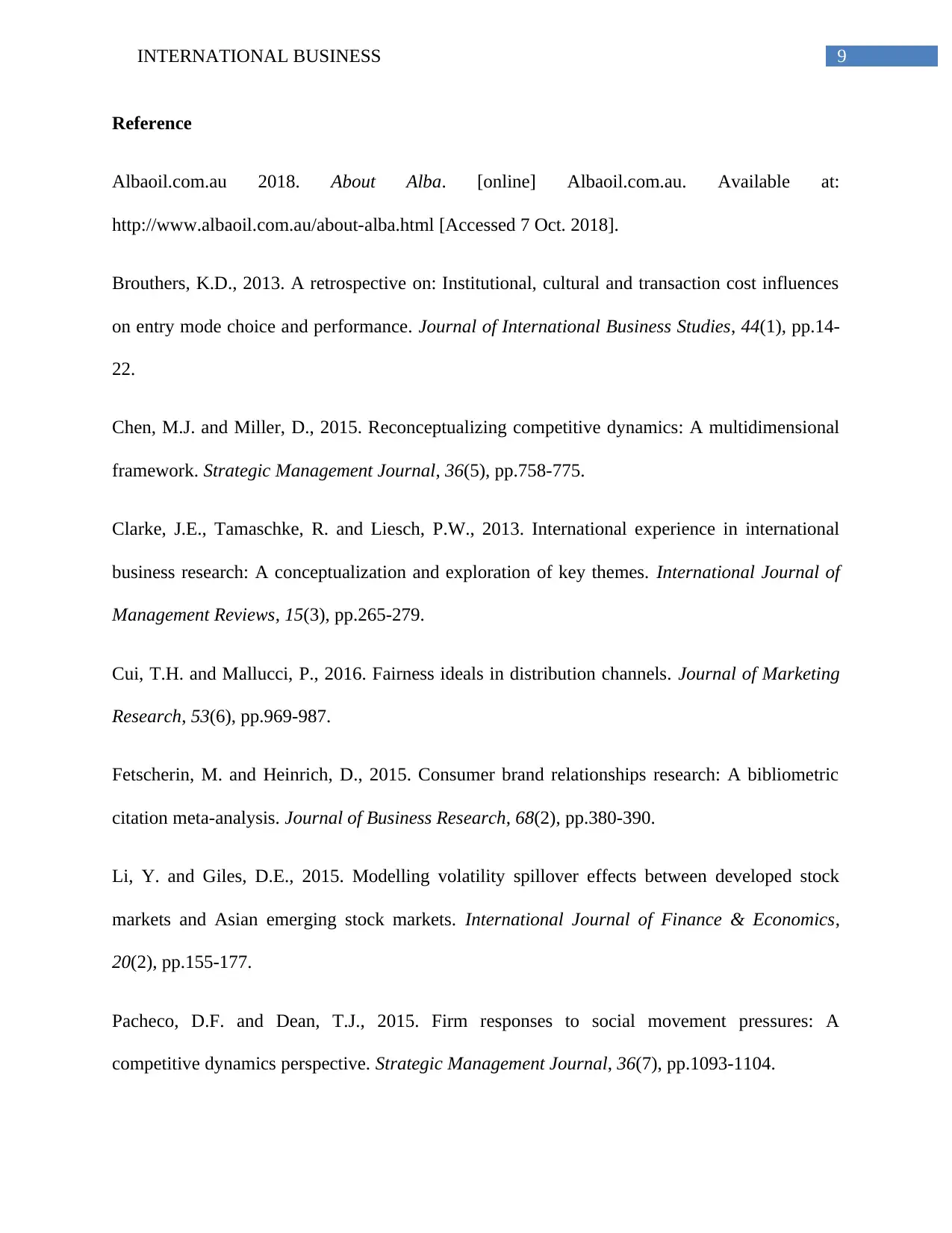
9INTERNATIONAL BUSINESS
Reference
Albaoil.com.au 2018. About Alba. [online] Albaoil.com.au. Available at:
http://www.albaoil.com.au/about-alba.html [Accessed 7 Oct. 2018].
Brouthers, K.D., 2013. A retrospective on: Institutional, cultural and transaction cost influences
on entry mode choice and performance. Journal of International Business Studies, 44(1), pp.14-
22.
Chen, M.J. and Miller, D., 2015. Reconceptualizing competitive dynamics: A multidimensional
framework. Strategic Management Journal, 36(5), pp.758-775.
Clarke, J.E., Tamaschke, R. and Liesch, P.W., 2013. International experience in international
business research: A conceptualization and exploration of key themes. International Journal of
Management Reviews, 15(3), pp.265-279.
Cui, T.H. and Mallucci, P., 2016. Fairness ideals in distribution channels. Journal of Marketing
Research, 53(6), pp.969-987.
Fetscherin, M. and Heinrich, D., 2015. Consumer brand relationships research: A bibliometric
citation meta-analysis. Journal of Business Research, 68(2), pp.380-390.
Li, Y. and Giles, D.E., 2015. Modelling volatility spillover effects between developed stock
markets and Asian emerging stock markets. International Journal of Finance & Economics,
20(2), pp.155-177.
Pacheco, D.F. and Dean, T.J., 2015. Firm responses to social movement pressures: A
competitive dynamics perspective. Strategic Management Journal, 36(7), pp.1093-1104.
Reference
Albaoil.com.au 2018. About Alba. [online] Albaoil.com.au. Available at:
http://www.albaoil.com.au/about-alba.html [Accessed 7 Oct. 2018].
Brouthers, K.D., 2013. A retrospective on: Institutional, cultural and transaction cost influences
on entry mode choice and performance. Journal of International Business Studies, 44(1), pp.14-
22.
Chen, M.J. and Miller, D., 2015. Reconceptualizing competitive dynamics: A multidimensional
framework. Strategic Management Journal, 36(5), pp.758-775.
Clarke, J.E., Tamaschke, R. and Liesch, P.W., 2013. International experience in international
business research: A conceptualization and exploration of key themes. International Journal of
Management Reviews, 15(3), pp.265-279.
Cui, T.H. and Mallucci, P., 2016. Fairness ideals in distribution channels. Journal of Marketing
Research, 53(6), pp.969-987.
Fetscherin, M. and Heinrich, D., 2015. Consumer brand relationships research: A bibliometric
citation meta-analysis. Journal of Business Research, 68(2), pp.380-390.
Li, Y. and Giles, D.E., 2015. Modelling volatility spillover effects between developed stock
markets and Asian emerging stock markets. International Journal of Finance & Economics,
20(2), pp.155-177.
Pacheco, D.F. and Dean, T.J., 2015. Firm responses to social movement pressures: A
competitive dynamics perspective. Strategic Management Journal, 36(7), pp.1093-1104.
Paraphrase This Document
Need a fresh take? Get an instant paraphrase of this document with our AI Paraphraser
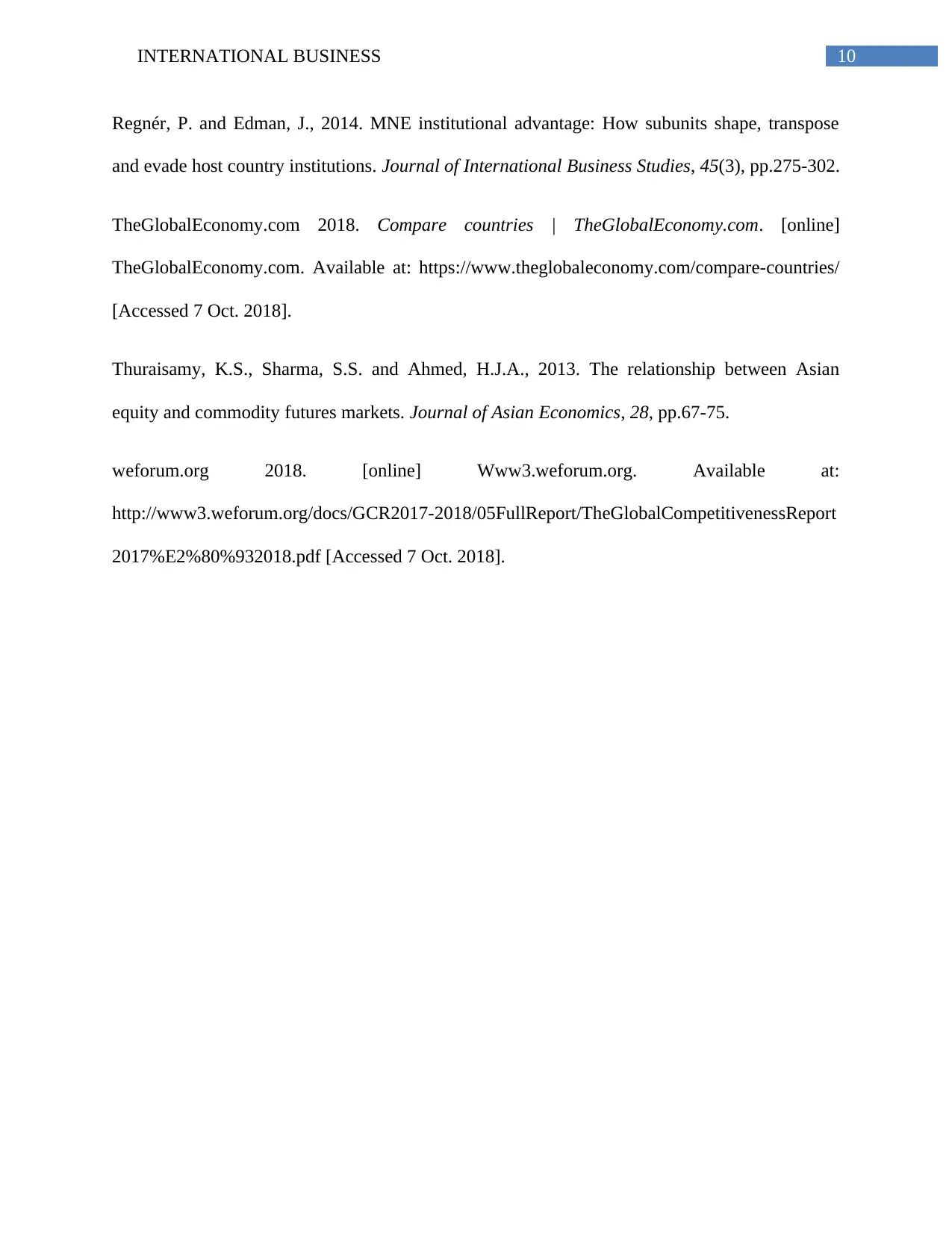
10INTERNATIONAL BUSINESS
Regnér, P. and Edman, J., 2014. MNE institutional advantage: How subunits shape, transpose
and evade host country institutions. Journal of International Business Studies, 45(3), pp.275-302.
TheGlobalEconomy.com 2018. Compare countries | TheGlobalEconomy.com. [online]
TheGlobalEconomy.com. Available at: https://www.theglobaleconomy.com/compare-countries/
[Accessed 7 Oct. 2018].
Thuraisamy, K.S., Sharma, S.S. and Ahmed, H.J.A., 2013. The relationship between Asian
equity and commodity futures markets. Journal of Asian Economics, 28, pp.67-75.
weforum.org 2018. [online] Www3.weforum.org. Available at:
http://www3.weforum.org/docs/GCR2017-2018/05FullReport/TheGlobalCompetitivenessReport
2017%E2%80%932018.pdf [Accessed 7 Oct. 2018].
Regnér, P. and Edman, J., 2014. MNE institutional advantage: How subunits shape, transpose
and evade host country institutions. Journal of International Business Studies, 45(3), pp.275-302.
TheGlobalEconomy.com 2018. Compare countries | TheGlobalEconomy.com. [online]
TheGlobalEconomy.com. Available at: https://www.theglobaleconomy.com/compare-countries/
[Accessed 7 Oct. 2018].
Thuraisamy, K.S., Sharma, S.S. and Ahmed, H.J.A., 2013. The relationship between Asian
equity and commodity futures markets. Journal of Asian Economics, 28, pp.67-75.
weforum.org 2018. [online] Www3.weforum.org. Available at:
http://www3.weforum.org/docs/GCR2017-2018/05FullReport/TheGlobalCompetitivenessReport
2017%E2%80%932018.pdf [Accessed 7 Oct. 2018].
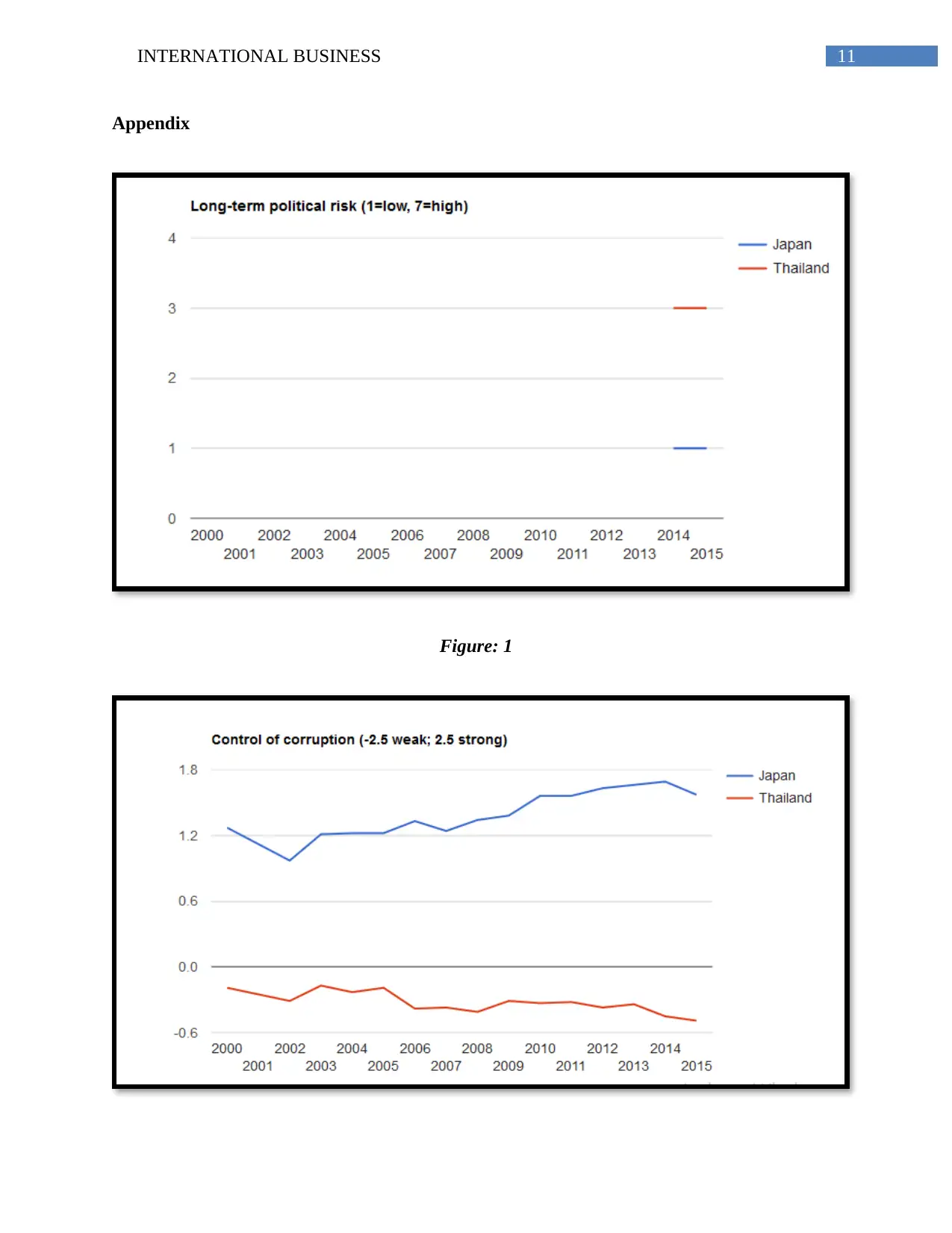
11INTERNATIONAL BUSINESS
Appendix
Figure: 1
Appendix
Figure: 1
⊘ This is a preview!⊘
Do you want full access?
Subscribe today to unlock all pages.

Trusted by 1+ million students worldwide
1 out of 16
Related Documents
Your All-in-One AI-Powered Toolkit for Academic Success.
+13062052269
info@desklib.com
Available 24*7 on WhatsApp / Email
![[object Object]](/_next/static/media/star-bottom.7253800d.svg)
Unlock your academic potential
Copyright © 2020–2025 A2Z Services. All Rights Reserved. Developed and managed by ZUCOL.





